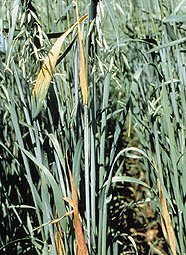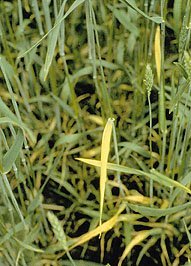Barley Yellow Dwarf Virus
Plants infected at an early growth stage (before the 4 to 5-leaf stage) may be severely stunted and may not head. Plants infected after the boot stage show few or no symptoms and may not suffer any yield losses.


Host Crops
Wheat, barley, oats and other grasses
Biology
Aphids acquire the virus by feeding on infected plants and spread the virus when they feed on healthy plants. The virus is not transmitted by seed or soil, but can overwinter in plants such as winter wheat. However, the spread of the disease is still dependent on aphids blowing in from the south to act as vectors. The build-up of aphid populations and extensive spread of this viral disease is favoured by winds from the south and by cool, moist summers (which also favour wheat and grasses).
Infections can occur throughout the season and are most abundant when there are high populations of aphids present. The leaf discolouration symptoms that indicate viral infection develop within about 2 weeks of inoculation at temperatures between 18-21°C. When infections occur at temperatures above 30°C, the symptoms do not develop.
Symptoms Of Damage
Leaf discolouration appears as shades of yellow, red or purple from tip to base and from margin to midrib. Look for yellowed or reddened leaves. Infected plants may be stunted and scattered among healthy plants. Note that these symptoms are sometimes confused with nutritional disorders, such as nitrogen deficiency.
Scouting Techniques
Look for stunted plants and leaves that have turned golden yellow from the tips downward.
Economic Thresholds
None available.
Control Tips
- Planting date affects the severity of the disease and yield loss. Early planted winter cereals and late planted spring cereals may be subject to high aphid populations at early growth stages, resulting in greater yield loss.
- Oat varieties differ in their susceptibility to this disease but there is no effective resistance in any of the cereal crops.
- Control volunteer wheat, barley and oats because they may serve as late season hosts to the aphids and virus.
